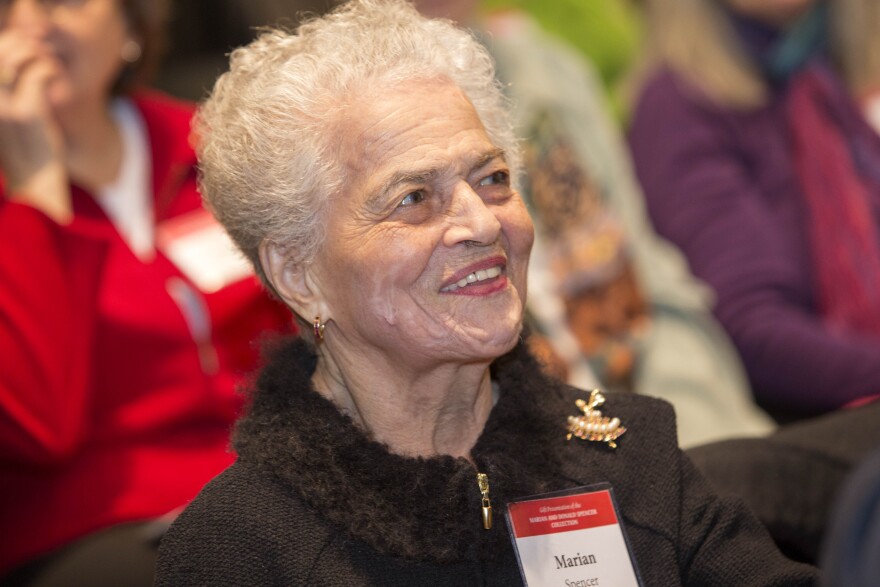Not far from Fifth Third Arena on the University of Cincinnati campus – where hundreds of friends and admirers of the late civil rights icon Marian Spencer met to celebrate her 99 years of life – there is a residence hall named after her.
Several of the many speakers at the memorial service for Mrs. Spencer, who died last month at the age of 99, made the point that when she was a young student at UC nearly 80 years ago, she couldn't live on campus because she was African American.
"Is it not amazing that students today can put their heads down at night in a residence hall named after her, when, decades ago, she wasn't allowed to do the same?" said UC President Neville Pinto of the young woman who graduated from UC in 1942 and later became a UC trustee.
"To call Marian a trailblazer is not enough,'' Pinto said. "She was so much more than that. She was filled with joy, filled with hope and devoid of hatred."
She met her husband of nearly 70 years, Donald Spencer, at UC when they were very young, and the two of them – along with other African American trailblazers on campus, challenged the then-president of the university himself and created new opportunities for black students to become part of the life of the university.

Her husband died in 2010.
They left behind two sons – Donald Jr. and Edward – both of whom spoke at Saturday's ceremony, along with Robert S. Brown, a white man who was adopted by the Spencers as a youth.
She was born in Gallipolis, Ohio, on June 28, 1920, the granddaughter of a former slave, Harry Alexander, who, several speakers said, taught her the value of education and the obligation she had to speak out against injustice. She herself would often speak of growing up in Gallipolis; and how she remembered watching with her grandfather as the Ku Klux Klan marched through the streets of the Ohio River town.
Retired federal Judge Nathaniel R. Jones spoke of his longtime friend as a figure who ranks with freedom fighters like Harriet Tubman and Rosa Parks.
Like them, Jones said, Marian Spencer was "courageous enough to lead people from the darkness of slavery and discrimination into the light of freedom."
Marian Spencer's life was a life full of "firsts": first African American president of the Woman's City Club of Greater Cincinnati; first woman president of the Cincinnati chapter of the NAACP; first African American woman elected to Cincinnati City Council. She served one term on council and was vice mayor.
Soon, there will be a new first for this indefatigable fighter for freedom.
Courtis Fuller, the WLWT news anchor who emceed the Saturday event, told the crowd that a committee had been formed to begin planning for a statue of Mrs. Spencer to be commissioned. The Woman's City Club is heavily involved in the project.
Tom Tsuchiya, the sculptor who did the statues of Cincinnati Reds legends outside Great American Ball Park, will do the Spencer statue. A preliminary drawing was shown on the arena's Jumbotron, which depicted Mrs. Spencer, her arms open to embrace two young children who are running to her side.
No one is quite sure where the statue will be located, but some people involved in the project said it is likely to be in the vicinity of the National Underground Railroad Freedom Center.
Organizers of the statue project say that of the roughly 100 statues throughout the city - from Abraham Lincoln to Oscar Robertson - Mrs. Spencer's statue would be the first of the a woman.
The audience at Fifth Third Arena Saturday was made up of local politicians (including one, David Mann, who served on council with Mrs. Spencer), educators, her sorority sisters from Alpha Kappa Alpha, fellow members of The Links, an international volunteer organization made up of African-American women, and many people who had worked on Mrs. Spencer's 1983 and 1985 city council campaigns.
But perhaps the people who touched the hearts of the audience the most were four fourth grade girls from the Winton Hills Academy who wrote and illustrated a book called Marian Spencer, A Light in the Darkness.

The book was shown, page by page, on the video board, followed by footage of a smiling and clearly delighted Mrs. Spencer meeting with the children.
The girls were brought up on the stage and brought flowers to Mrs. Spencer's sons and to Fuller.



